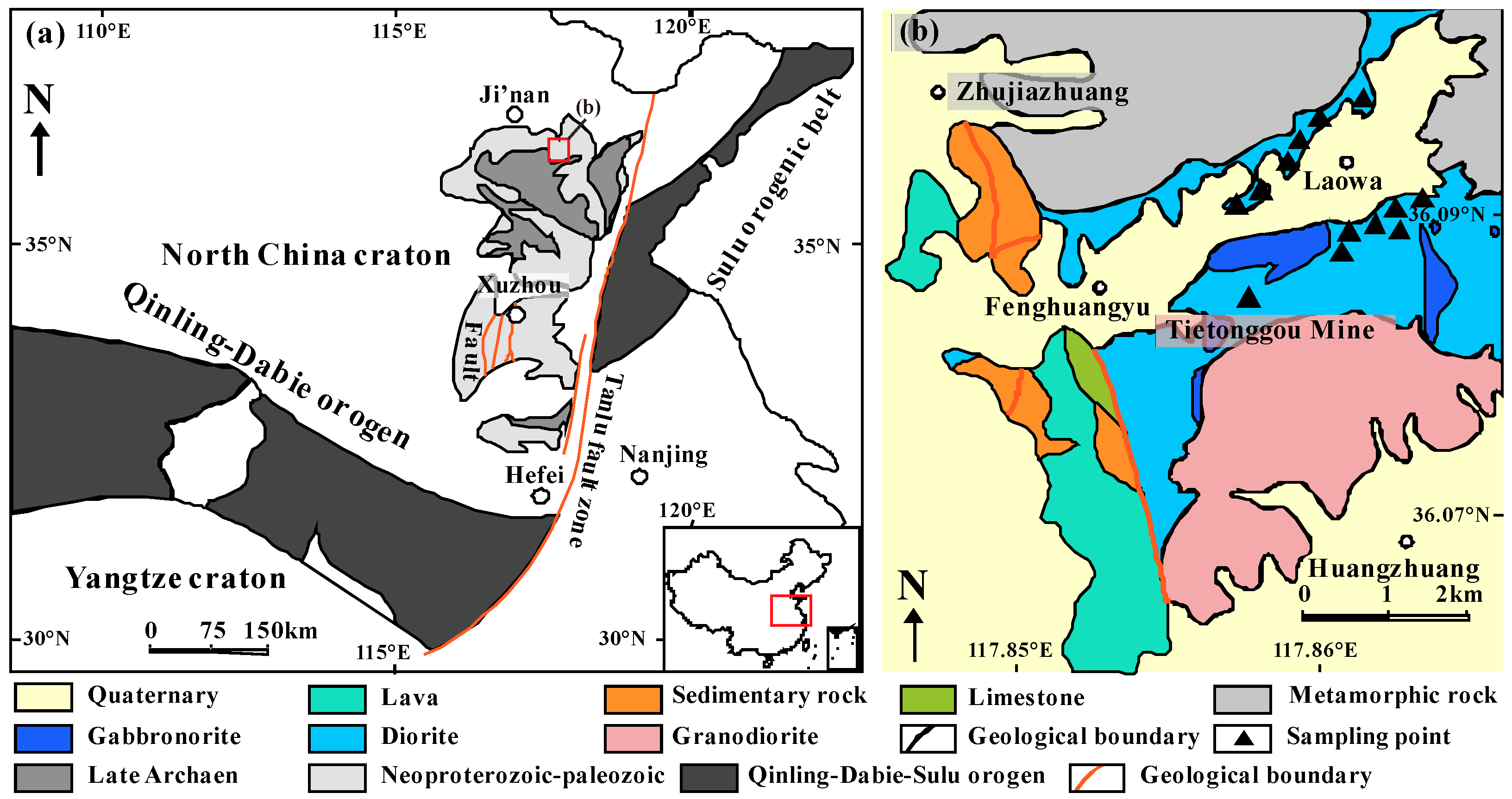Petrogenesis of the Early Cretaceous Tietonggou Diorite and Its Geological Implications
Abstract
1. Introduction
2. Geological Setting and Petrography
3. Methods
3.1. Whole-Rock Major Oxides and Trace Elements Analyses
3.2. Whole-Rock Pb Isotope Analysis
3.3. Zircon U-Pb Dating
4. Results
4.1. Whole-Rock Geochemistry
4.2. Pb Isotope Characteristics
4.3. Zircon U-Pb Geochronology
5. Discussion
5.1. Age of Pluton
5.2. Petrogenesis
5.3. Tectonic Implications
6. Conclusions
- (1)
- The western Shandong, located in the North China Craton, is one of the four major Fe–skarn deposit concentration areas in China, and the Tietonggou deposit is a representative deposit in this area. The study of the metallogenic age and source of ore-forming materials of the Tietonggou intrusion can contribute to the study of the Mesozoic magmatic evolution framework and the creation of the genetic model of Fe–skarn deposits in North China.
- (2)
- Geochemical characteristics of the Tietonggou pluton and its inclusions suggest that the parental magma may have originated mainly from the enriched lithospheric mantle with minor continental crustal input. The magma formation was caused by the subduction of the Yangtze beneath North China, and the Tietonggou pluton was formed under the extension during the thinning of the lithosphere in this period.
- (3)
- The view that the crustal input of metallogenic material in the Tietonggou deposit is derived from Archean North China or Paleo-Pacific materials could not be supported in this study.
- (4)
- More research is needed to compare the genetic conclusions of the Tietonggou pluton with other Mesozoic plutons in western Shandong and to summarize the similarities in the geneses of these plutons.
Supplementary Materials
Author Contributions
Funding
Data Availability Statement
Acknowledgments
Conflicts of Interest
References
- Chen, Y.; Bin, S.U.; Guo, S. The Dabie-Sulu orogenic peridotites: Progress and key issues. Sci. China Earth Sci. 2015, 1679–1699. [Google Scholar] [CrossRef]
- Lan, T.G.; Fan, H.R.; Hu, F.F.; Tomkins, A.G.; Yang, K.F.; Liu, Y. Multiple crust–mantle interactions for the destruction of the North China Craton: Geochemical and Sr–Nd–Pb–Hf isotopic evidence from the Longbaoshan alkaline complex. Lithos 2011, 122, 87–106. [Google Scholar] [CrossRef]
- Lan, T.G.; Fan, H.R.; Santosh, M.; Hu, F.F.; Yang, K.F.; Yang, Y.H.; Liu, Y. Early Jurassic high-K calc-alkaline and shoshonitic rocks from the Tongshi intrusive complex, eastern North China Craton: Implication for crust–mantle interaction and post-collisional magmatism. Lithos 2012, 140–141, 183–199. [Google Scholar] [CrossRef]
- Li, S.R.; Santosh, M. Metallogeny and craton destruction: Records from the North China Craton. Ore Geol. Rev. 2014, 56, 376–414. [Google Scholar] [CrossRef]
- Ma, Q.; Xu, Y.G.; Deng, Y.F.; Zheng, J.P.; Sun, M.; Griffin, W.L.; Xia, B.; Wang, C.Y. Similar crust beneath disrupted and intact cratons: Arguments against lower-crust delamination as a decratonization trigger. Tectonophysics 2019, 750, 1–8. [Google Scholar] [CrossRef]
- Si, S.; Zheng, Y.; Liu, B.; Tian, X. Structure of the mantle transition zone beneath the North China Craton. J. Asian Earth Sci. 2016, 116, 69–80. [Google Scholar] [CrossRef]
- Luo, Z.K.; Miao, L.C. Granite and Gold Deposits in Zhaolai Area, Jiaodong; Metallurgical Industry Press: Beijing, China, 2002. (In Chinese) [Google Scholar]
- Wang, L.G.; Qiu, Y.M.; Mcnaughton, N.J.; Groves, D.I.; Liu, Y.K. Constraints on crustal evolution and gold metallogeny in the Northwestern Jiaodong Peninsula, China, from SHRIMP U–Pb zircon studies of granitoids. Ore Geol. Rev. 1998, 13, 275–291. [Google Scholar] [CrossRef]
- Xu, W.L.; Wang, Q.H.; Wang, D.Y.; Pei, F.P.; Gao, S. Processes and mechanism of Mesozoic lithospheric thinning in eastern North China Craton: Evidence from Mesozoic igneous rocks and deep-seated xenoliths. Earth Sci. Front. 2004, 1, 309–317. (In Chinese) [Google Scholar]
- Zhai, M.G.; Fan, Q.C.; Zhang, H.F.; Sui, J.L. Lower crust processes during the lithosphere thinning in eastern China: Magma underplating, replacement and delamination. Acta Petrol. Sin. 2005, 21, 1509–1526. (In Chinese) [Google Scholar]
- Zhao, D.; You, T.; Lei, J.; Liu, L.; Zheng, S. Seismic image and origin of the Changbai intraplate volcano in East Asia: Role of big mantle wedge above the stagnant Pacific slab. Phys. Earth Planet. Inter. 2009, 173, 197–206. [Google Scholar] [CrossRef]
- Yu, L.D.; Yu, X.F.; Li, D.P.; Liu, Q.; Liu, J.J.; Shu, L.; Wei, P.F. Zircon U–Pb Chronology, Geochemistry Characteristics of the Tiezhai Complex in Linqu County of Western Shandong and Their Geological Significance. Geoscience 2020, 34, 418–430. (In Chinese) [Google Scholar]
- Ning, P.S.; Long, Q.; Cheng, T.; Hu, Z.P.; Cheng, F.K. Geochemistry and Sr–Nd–Pb Isotopic Composition of Late Mesozoic Intermediate-basic Rock in Western Shandong Block. J. Earth Sci. Environ. 2013, 35, 62–76. (In Chinese) [Google Scholar]
- Wang, D.Y.; Xu, W.L.; Lan, X.; Wang, Q.H. Petrogenesis of pyroxenite xenoliths in Mesozoic gabbro-diorite from western Shandong Province, China. J. Jilin Univ. Earth Sci. Ed. 2004, 34, 167–173. (In Chinese) [Google Scholar]
- Wu, X.Y.; Xu, Y.G.; Ma, J.L.; Xu, J.F.; Wang, Q. Geochemistry and petrogenesis of the Mesozoic high Mg diorites from western Shandong. Geotecton. Et Metallog. 2003, 27, 228–236. (In Chinese) [Google Scholar]
- Yang, C.H.; Xu, W.L.; Yang, D.S.; Liu, C.C.; Liu, X.M.; Hu, Z.C. Petrogenesis of the Mesozoic High-Mg Diorites in West Shandong: Evidence from Chronology and Petro-geochemistry. Earth Sci. 2006, 31, 81–92. (In Chinese) [Google Scholar]
- Yang, Q.L.; Zhao, Z.F.; Zheng, Y.F. Slab–mantle interaction in continental subduction channel: Geochemical evidence from Mesozoic gabbroic intrusives in southeastern North China. Lithos 2012, 155, 442–460. [Google Scholar] [CrossRef]
- Yang, C.H. Chronology and Geochemistry of Mesozoic High-Mg Diorites in Western Shandong: Constraints on Lithospheric Evolution of the North China Craton; Jilin University: Jilin, China, 2007. (In Chinese) [Google Scholar]
- Song, M.C.; Wang, P.C. Regional Geology of Shandong Province; Shandong Map Publishing House: Jinan, China, 2003. (In Chinese) [Google Scholar]
- Dong, Z.X. Yanshanian Intrusive Rocks and Mineralization in Central Shandong; Geological Publishing House: Bath, UK, 1987. (In Chinese) [Google Scholar]
- Zhou, Q.J. Petrogenesis of Wehrlite and Pyroxenite Xenoliths in Early Cretaceous Igneous Rocks from Western Shandong, China; Jilin University: Jilin, China, 2014. (In Chinese) [Google Scholar]
- Xu, W.L.; Chi, X.G.; Yuan, C.; Huang, Y.M.; Wang, W. Mesozoic Dioritic Rocks and Deep-Seated Inclusions in Central North China Platform; Geological Publishing House: Beijing, China, 1993. (In Chinese) [Google Scholar]
- Sannac, S.; Tadjiki, S.; Moldenhauer, E. Single particle analysis using the Agilent 7700x ICP-MS 2013. Available online: https://www.agilent.com/Library/applications/5991-2929EN.pdf (accessed on 2 April 2024).
- Weis, D.; Kieffer, B.; Maerschalk, C.; Barling, J.; Jong, J.D.; Williams, G.A.; Scoates, J.S. High-precision isotopic characterization of USGS reference materials by TIMS and MC-ICP-MS. Geochem. Geophys. Geosystems 2006, 7, 139–149. [Google Scholar] [CrossRef]
- Wiedenbeck, M.; Allé, P.; Corfu, F.; Griffin, W.L.; Meier, M.; Oberli, F.; Von Quadt, A.; Roddick, J.C.; Spiegel, W. Three natural zircon standards for U-Th-Pb, Lu-Hf, trace element and REE analyses. Geostand. Newsl. 1995, 19, 1–23. [Google Scholar] [CrossRef]
- Wiedenbeck, M.; Hanchar, J.M.; Peck, W.H.; Sylvester, P.; Valley, J.; Whitehouse, M.; Kronz, A.; Morishita, Y.; Nasdala, L.; Fiebig, J.; et al. FurtherCharacterisation of the 91500 Zircon Crystal. Geostand. Geoanalytical Res. 2004, 28, 9–39. [Google Scholar] [CrossRef]
- Jackson, S.E.; Pearson, N.J.; Griffin, W.L. The applcation of laser ablation-inductively coupled plasma-mass spectrometry to in situ U-Pb zircon geochronology. Chem. Geol. 2004, 211, 47–69. [Google Scholar] [CrossRef]
- Yuan, H.L.; Gao, S.; Liu, X.M.; Li, H.M.; Detlef, G.; Wu, F.Y. Accurate U-Pb Age and Trace Element Determinations of Zircon by Laser Ablation-Inductively Coupled Plasma-Mass Spectrometry. Geostand. Geoanalytical Res. 2007, 28, 353–370. [Google Scholar] [CrossRef]
- Middlemost, E. Naming materials in the magma/igneous rock system. Earth-Sci. Rev. 1994, 37, 215–224. [Google Scholar] [CrossRef]
- Irvine, T.N.; Baragar, W.R.A. A Guide to the Chemical Classification of the Common Volcanic Rocks. Can. J. Earth Sci. 1971, 8, 523–548. [Google Scholar] [CrossRef]
- Papu, D.M.; Philip, M.P. Tectonic discrimination of granitoids. Geol. Soc. Am. Bull. 1989, 101, 635–643. [Google Scholar]
- Wright, J.B. A simple alkalinity ratio and its application to questions of non-orogenic granite genesis. Geol. Mag. 1969, 106, 370–384. [Google Scholar] [CrossRef]
- Kelemen, P.B.; Shimizu, N.; Dunn, T. Relative depletion of niobium in some arc magmas and the continental crust: Partitioning of K, Nb, La and Ce during melt/rock reaction in the upper mantle. Earth Planet. Sci. Lett. 1993, 120, 111–134. [Google Scholar] [CrossRef]
- Liu, Y.J.; Liu, B.Q.; Feng, Z.Q.; Wen, Q.B.; Li, W.M.; Zhang, T.A.; Du, B.Y. SIMS Zircon U–Pb Age, Petrogeochemistry and Its Tectonic Implication of Laodaokou Diorite in the Mid-North Part of Great Xing’an Range. J. Jilin Univ. Earth Sci. Ed. 2016, 46, 482–498. (In Chinese) [Google Scholar]
- Boynton, W.V. Geochemistry of the rare earth elements: Meteorite studies. In Rare Earth Element Geochemistry 2; Elsevier: Amsterdam, The Netherlands, 1984. [Google Scholar]
- Taylor, S.R.; McLennan, S.M. The Continental Crust: Its Composition and Evolution; Blackwell: Hoboken, NJ, USA, 1985. [Google Scholar]
- Yang, C.H.; Xu, W.L.; Yang, D.S.; Wang, W.; Wang, W.D.; Liu, J.M. Petrogenesis of shangyu gabbro-diorites in western shandong: Geochronological and geochemical evidence. Sci. China Ser. D Earth Sci. 2008, 51, 481–492. [Google Scholar] [CrossRef]
- Li, S.G.; Yang, W. Decoupling of surface and subsurface sutures in the Dabie orogen and a continent-collisional lithospheric-wedging model: Sr-Nd-Pb isotopic evidences of Mesozoic igneous rocks in eastern China. Chin. Sci. Bull. 2003, 48, 831–838. [Google Scholar] [CrossRef]
- Yan, J.; Cheng, J.F.; Yu, G.; Qian, H.; Zhou, T.X. Pb Isotopic Characteristics of Late Mesozoic Mafic Rocks from the Lower Yangtze Region: Evidence for Enriched Mantle. Geol. J. China Univ. 2003, 9, 195–206. (In Chinese) [Google Scholar]
- Yang, D.B.; Xu, W.L.; Pei, F.P.; Yang, C.H.; Wang, Q.H. Spatial extent of the influence of the deeply subducted South China Block on the southeastern North China Block: Constraints from Sr–Nd–Pb isotopes in Mesozoic mafic igneous rocks. Lithos 2012, 136–139, 246–260. [Google Scholar] [CrossRef]
- Stanley, R.H. A large-scale isotope anomaly in the Southern Hemisphere mantle. Nature 1984, 309, 753–757. [Google Scholar]
- Hu, F.F.; Fan, H.R.; Yang, J.H.; Wan, Y.S.; Liu, D.; Zhai, M.G.; Jin, C.W. Metallogenic age of gold bearing quartz vein type gold deposit in Rushan, Eastern Shandong: U–Pb determination by hydrothermal zircon SHRIMP method. Chin. Sci. Bull. 2004, 49, 1191–1198. (In Chinese) [Google Scholar]
- Wang, S.J.; Zhang, C.J.; Yang, E.X.; Song, Z.Y.; Wang, L.F.; Xu, K.M. Division of Mesozoic Intrusive Stages in Luxi Area. Shandong Land Resour. 2009, 25, 18–23. (In Chinese) [Google Scholar]
- Xu, W.L.; Wang, D.Y.; Wang, Q.H.; Pei, F.P.; Lin, J.Q. 40Ar/39Ar dating of hornblende and biotite in Mesozoic intrusive complex from the North China Block: Constraints on the time of lithospheric thinning. Geochimica 2004, 33, 221–231. (In Chinese) [Google Scholar]
- Wu, F.Y.; Lin, J.Q.; Wilde, S.A.; Zhang, X.; Yang, J.H. Nature and significance of the Early Cretaceous giant igneous event in eastern China. Earth Planet. Sci. Lett. 2005, 233, 103–119. [Google Scholar] [CrossRef]
- Yang, D.B.; Xu, W.L.; Pei, F.P.; Wang, Q.H.; Gao, S. Chronology and Pb isotope compositions of Early Cretaceous adakitic rocks in Xuzhou-Huaibei area, central China: Constraints on magma sources and tectonic evolution in the eastern North China Craton. Acta Petrol. Sin. 2008, 24, 1745–1758. (In Chinese) [Google Scholar]
- Rapp, R.P.; Watson, E.B. Dehydration Melting of Metabasalt at 8–32 kbar: Implications for Continental Growth and Crust-Mantle Recycling. J. Petrol. 1995, 36, 891–931. [Google Scholar] [CrossRef]
- Green, T.H. Significance of Nb/Ta as an indicator of geochemical processes in the crust-mantle system. Chem. Geol. 1995, 120, 347–359. [Google Scholar] [CrossRef]
- Ionov, D.A.; Griffin, W.L.; O’Reilly, S.Y. Volatile-bearing minerals and lithophile trace elements in the upper mantle. Chem. Geol. 1997, 141, 153–184. [Google Scholar] [CrossRef]
- McDonough, W.F.; Sun, S.S. The composition of the Earth. Chem. Geol. 1995, 120, 223–253. [Google Scholar] [CrossRef]
- Zhang, C.; Cui, F.H.; Zhang, Z.L.; Geng, R.; Song, M.C. Petrogenesis of Ore-Bearing Dioritic Pluton in Jinling Area in WesternShandong: Evidence from Zircon U-Pb Chronology and Petro-Geochemistry. J. Jilin Univ. Earth Sci. 2017, 47, 1732–1745. [Google Scholar]
- Wood, D.A.; Tarney, J.; Varet, J.; Saunders, A.D.; Cann, J.R. Geochemistry of basalts drilled in the North Atlantic by IPOD Leg 49: Implications for mantle heterogeneity. Earth Planet. Sci. Lett. 1979, 42, 77–97. [Google Scholar] [CrossRef]
- Oreskes, N.; Einaudi, M.T. Origin of rare earth element-enriched hematite breccias at the Olympic Dam Cu-U-Au-Ag deposit, Roxby Downs, South Australia. Econ. Geol. 1990, 85, 1–28. [Google Scholar] [CrossRef]
- Wang, D.Z.; Zhou, X.M. Genesis and Crustal Evolution of Late Mesozoic Granitic Volcanic Intrusive Complexes in Southeastern China; Science Press: Beijing, China, 2002. (In Chinese) [Google Scholar]
- Wu, F.Y.; Han, R.H.; Yang, J.H.; Wilde, S.A.; Zhai, M.G.; Park, S.C. Initial constraints on the timing of granitic magmatism in North Korea using U–Pb zircon geochronology. Chem. Geol. 2007, 238, 232–248. [Google Scholar] [CrossRef]
- Xu, Y.G.; Huang, X.L.; Ma, J.L. Crust-mantle interaction during the tectono-thermal reactivation of the North China Craton: Constraints from SHRIMP zircon U–Pb chronology and geochemistry of Mesozoic plutons from western Shandong. Contrib. Mineral. Petrol. 2004, 147, 750–767. [Google Scholar] [CrossRef]
- Zhu, R.X.; Chen, L.; Wu, F.Y.; Liu, J.L. Timing, scale and mechanism of the destruction of the North China Craton. Sci. China Earth Sci. 2011, 54, 789–797. [Google Scholar] [CrossRef]
- Zhu, R.X.; Xu, Y.G. Subduction of the Western Pacific plate and destruction of the North China Craton. Sci. China Earth Sci. 2019, 62, 1340–1350. [Google Scholar] [CrossRef]
- Goss, S.C.; Wilde, S.A.; Wu, F.; Yang, J. The age, isotopic signature and significance of the youngest Mesozoic granitoids in the Jiaodong Terrane, Shandong Province, North China Craton. Lithos 2010, 120, 309–326. [Google Scholar] [CrossRef]
- Yang, Q.Y.; Santosh, M. Early Cretaceous magma flare-up its implications on gold mineralization in the Jiaodong Peninsula, China. Ore Geol. Rev. 2015, 65, 626–642. [Google Scholar] [CrossRef]
- Deng, C.Z.; Gou, J.; Sun, D.Y.; Sun, G.Y.; Tian, Z.D.; Lehmann, B.; Moynier, F.; Yin, R.S. Mercury isotopic composition of igneous rocks from an accretionary orogen: Implications for lithospheric recycling. Geology 2022, 50, 1001–1006. [Google Scholar] [CrossRef]
- Deng, C.Z.; Fu, A.Z.; Geng, H.Y.; Sun, D.Y.; Zhao, G.C.; Mao, G.Z.; Moynier, F.; Lehmann, B.; Yin, R.S. Low-δ18O and negative Δ199Hg felsic igneous rocks in NE China: Implications for Early Cretaceous orogenic thinning. Chem. Geol. 2023, 633, 121569. [Google Scholar] [CrossRef]
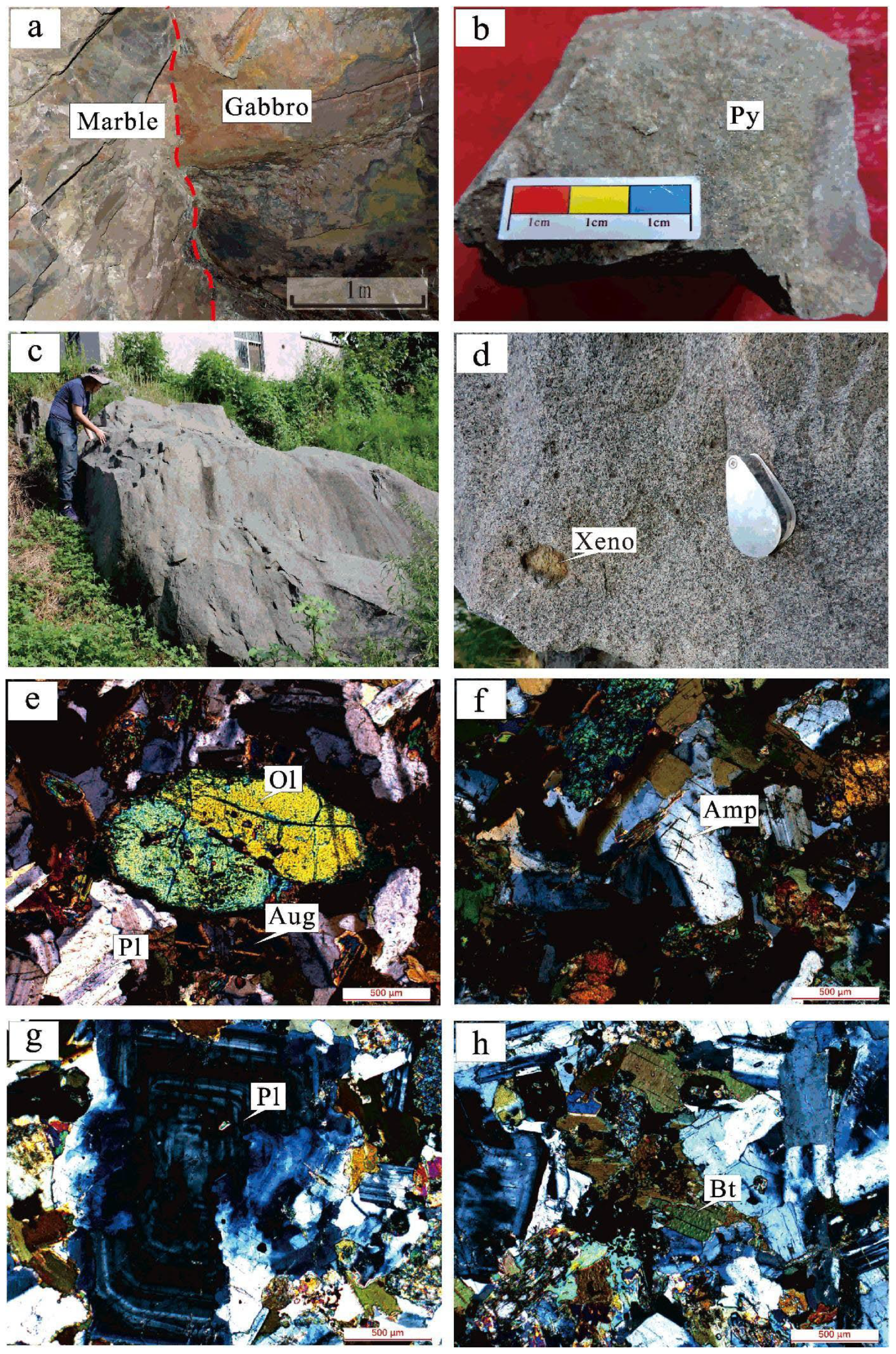
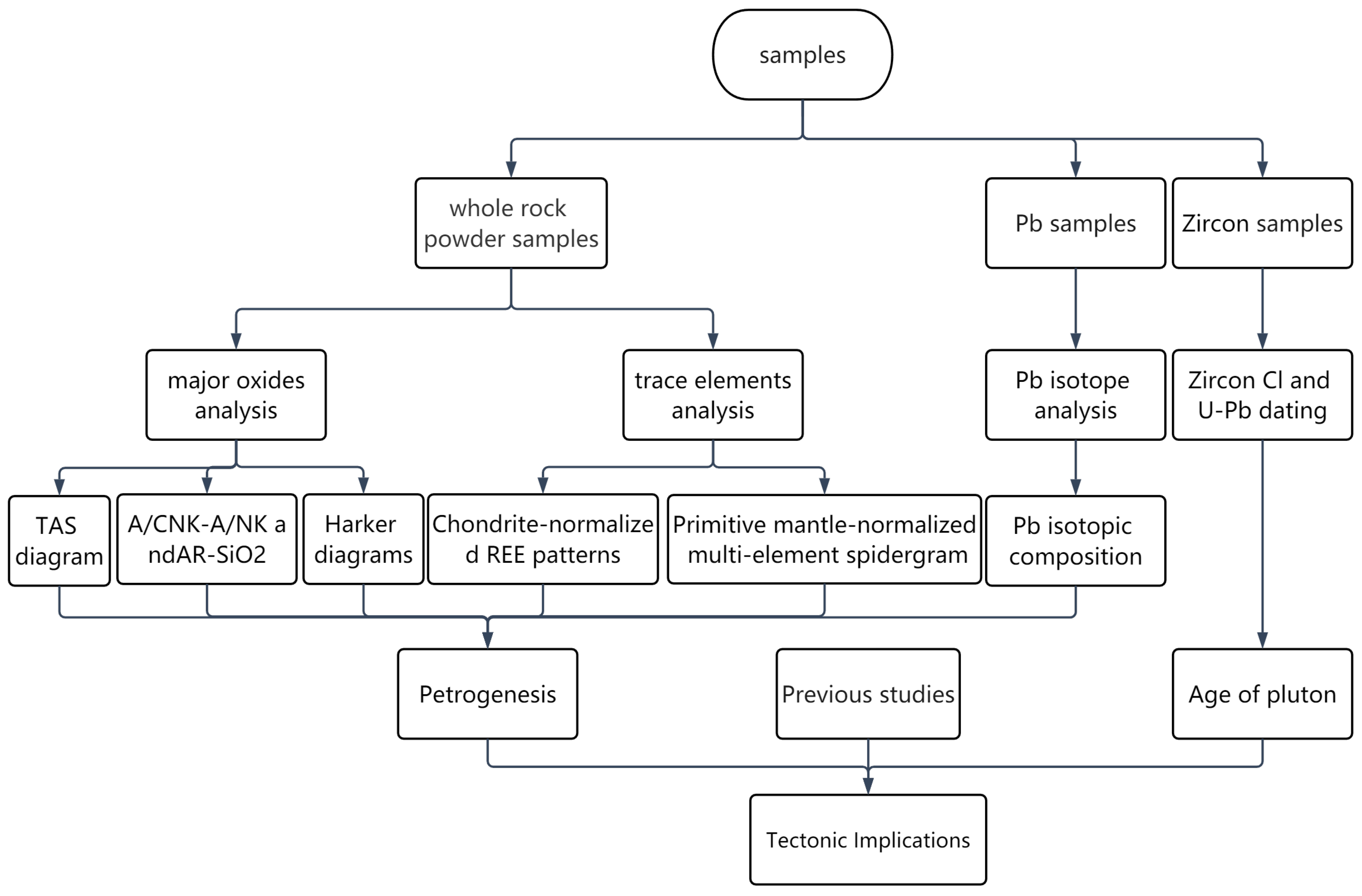
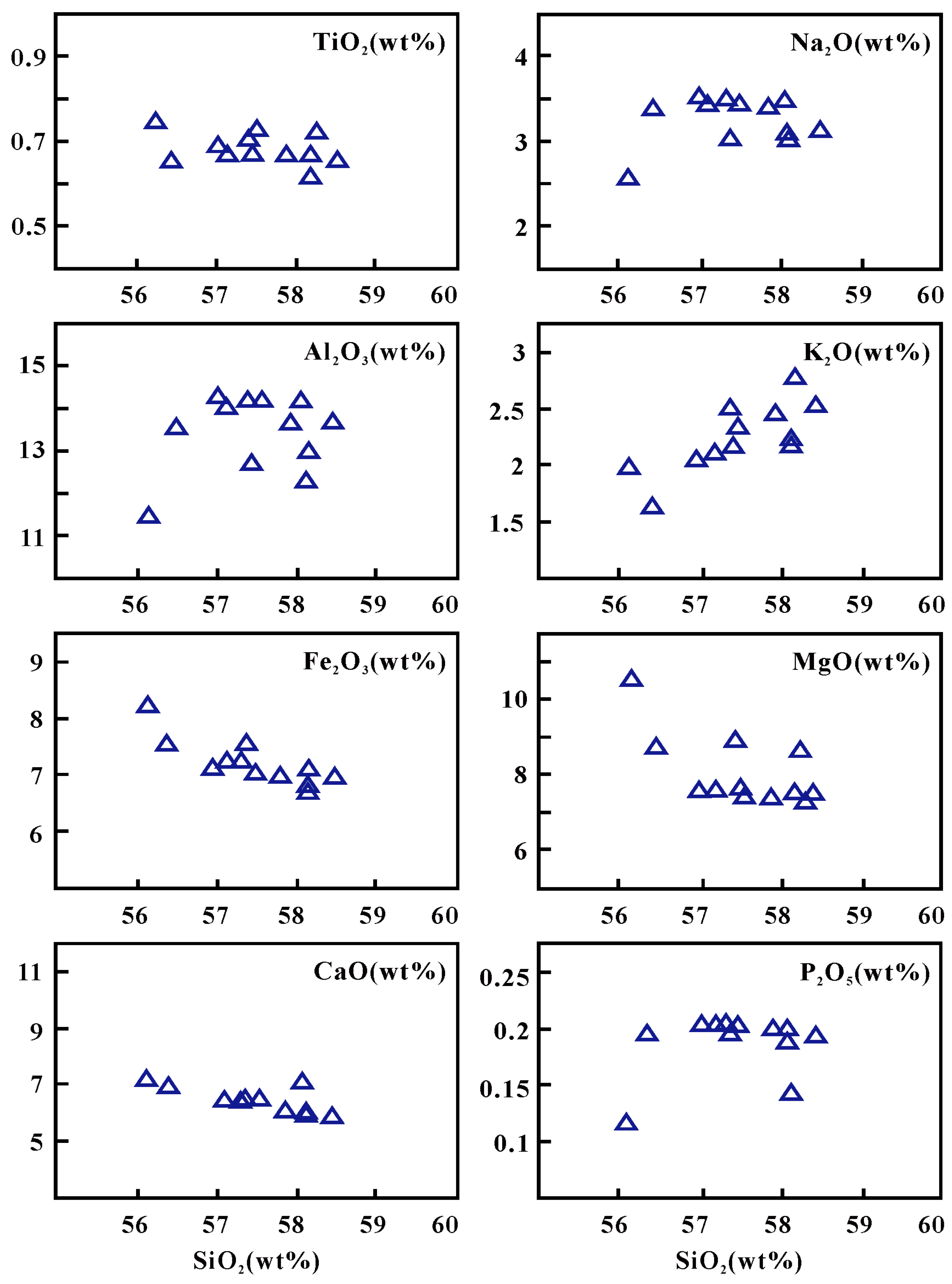
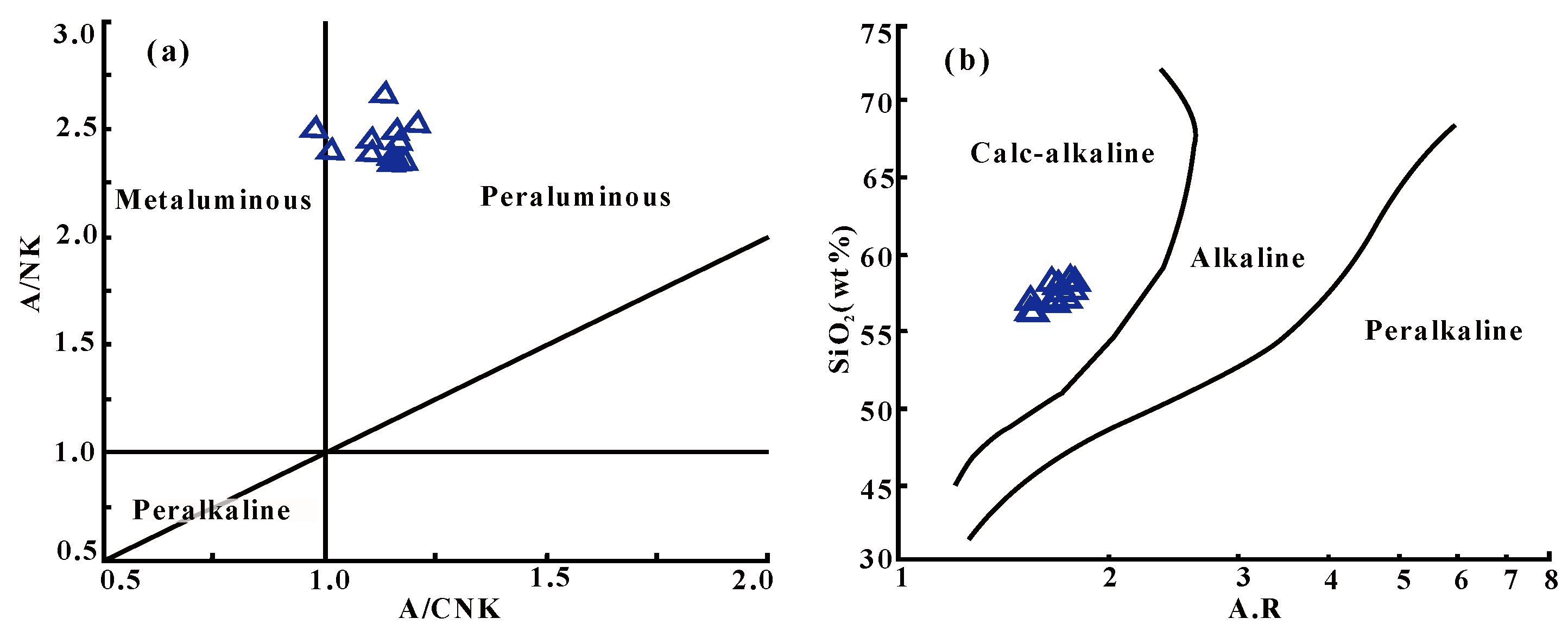
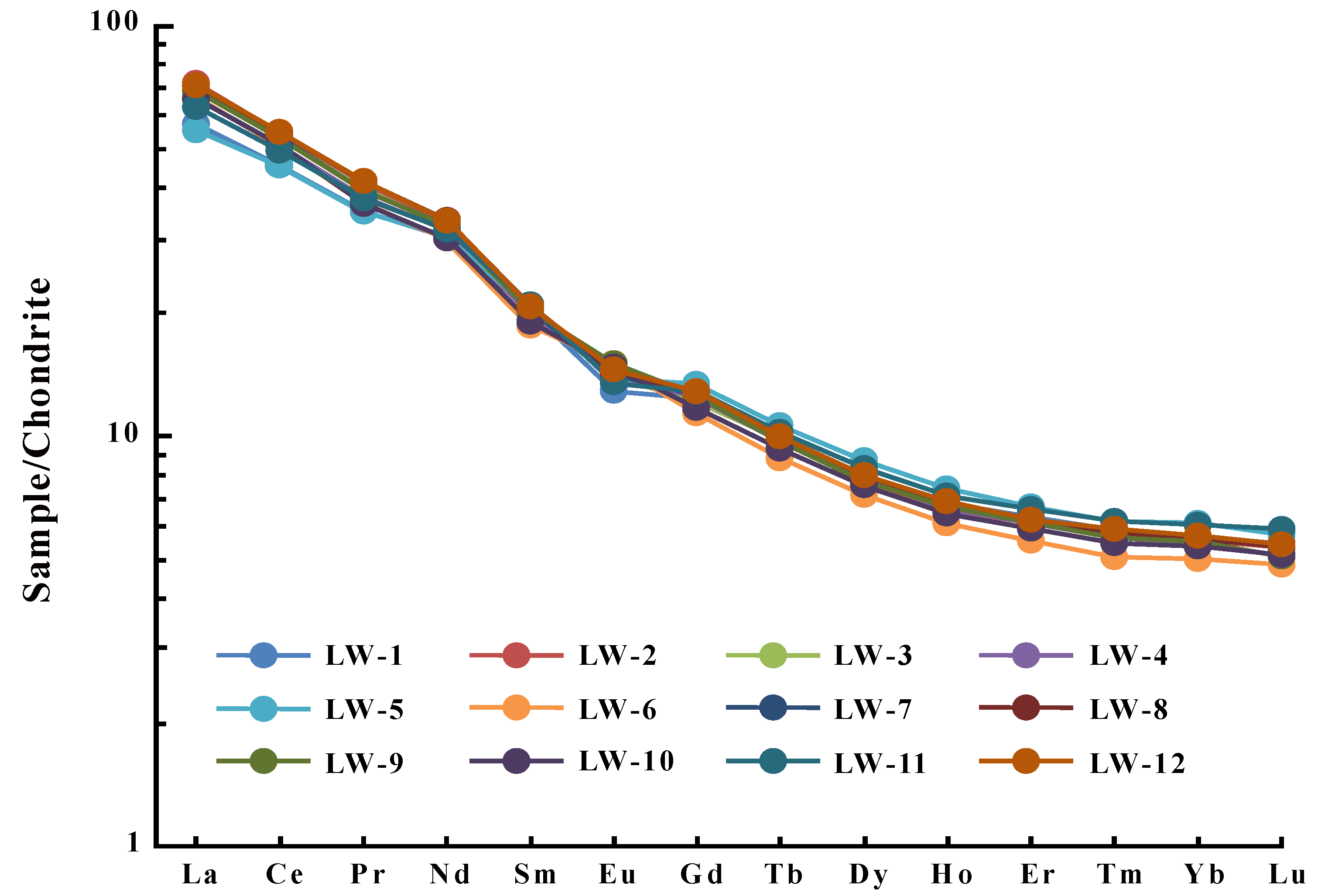

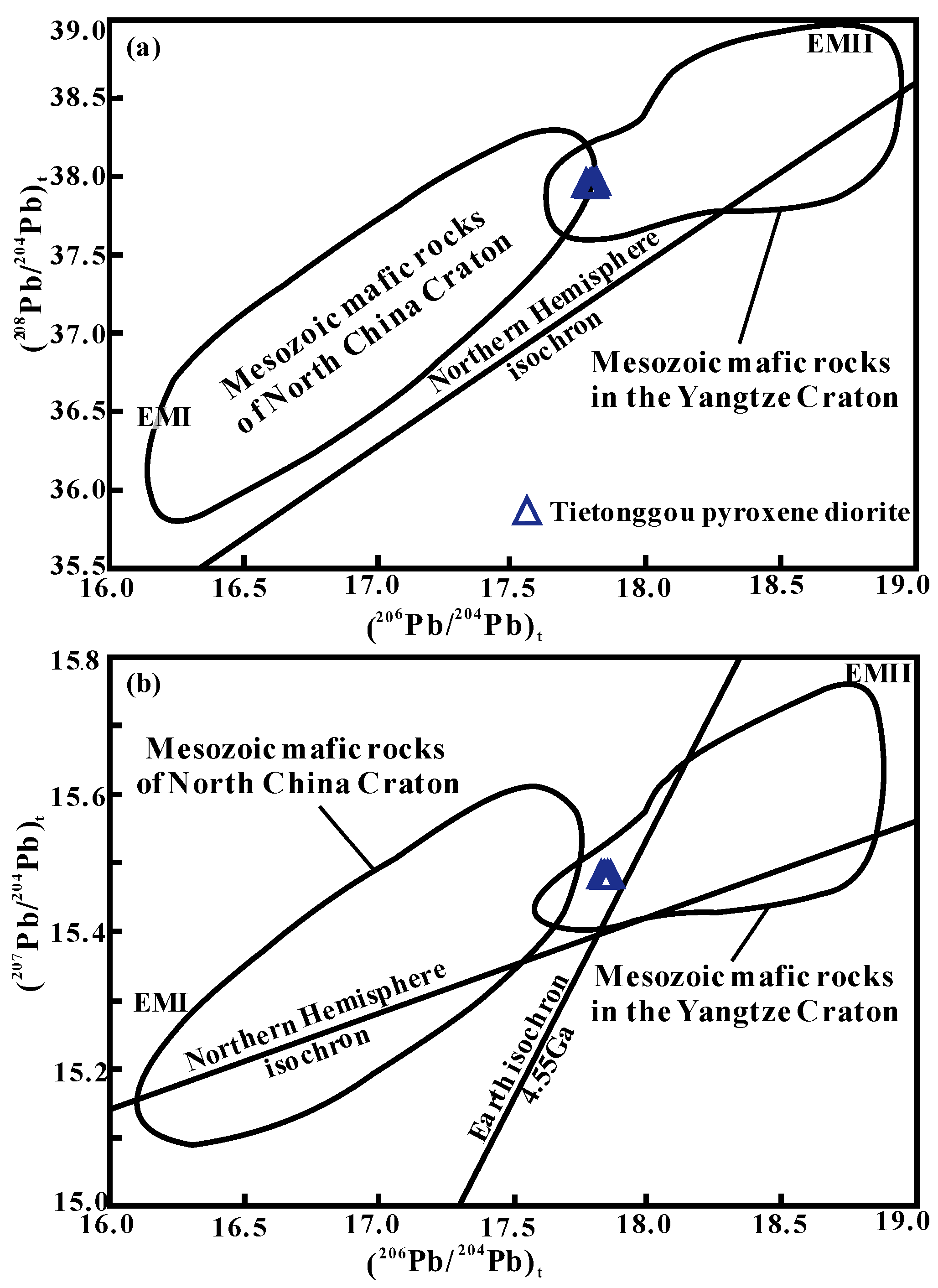



| Major Oxides in wt% | Diorite (n = 10) | Meladiorite | Major Oxides in wt% | Diorite (n = 10) | Meladiorite | ||||||
|---|---|---|---|---|---|---|---|---|---|---|---|
| Min | Mean | Max | LW-5 | LW-6 | Min | Mean | Max | LW-5 | LW-6 | ||
| Na2O | 2.94 | 3.28 | 3.46 | 2.57 | 3.49 | MnO | 0.11 | 0.11 | 0.12 | 0.13 | 0.11 |
| MgO | 7.14 | 7.83 | 8.83 | 10.43 | 7.58 | Fe2O3 | 6.67 | 7.11 | 7.59 | 8.21 | 7.16 |
| Al2O3 | 12.23 | 13.4 | 14.15 | 11.31 | 14.11 | LOI | 0.28 | 0.51 | 0.79 | 0.88 | 0.58 |
| SiO2 | 56.4 | 57.6 | 58.38 | 56.17 | 56.91 | Total | 99.15 | 99.4 | 99.64 | 99.77 | 99.3 |
| P2O5 | 0.14 | 0.19 | 0.21 | 0.12 | 0.21 | K2O + Na2O | 5.02 | 5.55 | 5.99 | 4.5 | 5.54 |
| K2O | 1.63 | 2.27 | 2.55 | 1.92 | 2.05 | A/NK | 2.33 | 2.42 | 2.66 | 2.51 | 2.55 |
| CaO | 5.99 | 6.41 | 7.2 | 7.29 | 6.43 | A/CNK | 1.02 | 1.12 | 1.16 | 0.96 | 1.18 |
| TiO2 | 0.62 | 0.67 | 0.72 | 0.73 | 0.68 | Na2O/K2O | 1.29 | 1.46 | 2.07 | 1.34 | 1.7 |
| Trace and Rare Earth Elements in ppm | Diorite (n = 10) | Meladiorite | Trace and Rare Earth Elements in ppm | Diorite (n = 10) | Meladiorite | ||||||
| Min | Mean | Max | LW-5 | LW-6 | Min | Mean | Max | LW-5 | LW-6 | ||
| Li | 19.3 | 21.83 | 24.8 | 23.6 | 21.3 | Ho | 0.47 | 0.501 | 0.52 | 0.55 | 0.45 |
| Be | 1.53 | 1.643 | 1.75 | 1.5 | 1.54 | Er | 1.27 | 1.348 | 1.42 | 1.46 | 1.2 |
| Sc | 17.9 | 19.56 | 22.5 | 25.9 | 18.2 | Tm | 0.18 | 0.194 | 0.2 | 0.21 | 0.17 |
| Ti | 3705 | 3907.6 | 4258 | 4356 | 3912 | Yb | 1.15 | 1.214 | 1.3 | 1.32 | 1.08 |
| V | 139 | 147.8 | 164 | 174 | 146 | Lu | 0.17 | 0.178 | 0.19 | 0.19 | 0.16 |
| Cr | 587 | 676.9 | 857 | 922 | 651 | Hf | 2.94 | 3.492 | 5.05 | 2.56 | 3.07 |
| Mn | 813 | 858.5 | 919 | 1033 | 852 | Ta | 0.39 | 0.447 | 0.5 | 0.42 | 0.42 |
| Co | 27.4 | 29.8 | 33.2 | 39.3 | 28.8 | Pb | 14.5 | 16.95 | 18.8 | 12.7 | 16.3 |
| Ni | 161 | 178.7 | 207 | 247 | 170 | Th | 5.34 | 6.564 | 7.92 | 6.24 | 6.26 |
| Cu | 2.07 | 36.131 | 178 | 205 | 51.4 | U | 1.42 | 1.878 | 2.13 | 1.71 | 1.65 |
| Zn | 70.9 | 79.08 | 82.5 | 83 | 76.3 | Nb/Ta | 14.44 | 15.792 | 16.82 | 14.27 | 14.76 |
| Ga | 17.7 | 18.75 | 19.7 | 16.4 | 18.4 | Rb/Sr | 0.1 | 0.13 | 0.16 | 0.16 | 0.11 |
| As | 6.95 | 7.392 | 7.99 | 6.76 | 6.24 | Ba/Rb | 9.56 | 12.183 | 14.08 | 12.48 | 13.6 |
| Se | 0.54 | 0.649 | 0.83 | 0.61 | 0.47 | Zr/Hf | 35.42 | 37.659 | 39.14 | 34.82 | 37.51 |
| Rb | 51.6 | 63.1 | 68.2 | 59.6 | 56.8 | La/Sm | 4.51 | 5.299 | 5.67 | 4.25 | 5.71 |
| Sr | 419 | 483.9 | 525 | 382 | 523 | Zr/Nb | 14.79 | 18.869 | 28.02 | 15.03 | 18.62 |
| Y | 12.4 | 13.45 | 14 | 14.7 | 12.1 | Ta/La | 0.02 | 0.021 | 0.03 | 0.02 | 0.02 |
| Zr | 104 | 132 | 198 | 89.2 | 115 | Ce/Pb | 2.32 | 2.547 | 2.84 | 2.94 | 2.57 |
| Nb | 5.67 | 7.038 | 7.61 | 5.94 | 6.18 | Hf/Sm | 0.71 | 0.862 | 1.22 | 0.62 | 0.82 |
| Mo | 3.85 | 4.656 | 5.51 | 3.76 | 4.16 | Nb/La | 0.27 | 0.329 | 0.39 | 0.34 | 0.29 |
| Sn | 1.24 | 1.34 | 1.47 | 1.22 | 1.4 | Th/La | 0.26 | 0.305 | 0.34 | 0.35 | 0.29 |
| Cs | 4.07 | 4.58 | 5.12 | 3.69 | 4.05 | Y/Ho | 26.26 | 26.807 | 27.83 | 26.69 | 26.63 |
| Ba | 493 | 771.2 | 840 | 743 | 773 | Co/Ni | 0.16 | 0.168 | 0.17 | 0.16 | 0.17 |
| La | 18.5 | 21.46 | 23.2 | 17.6 | 21.3 | (La/Yb)N | 10.13 | 11.954 | 12.84 | 8.99 | 13.3 |
| Ce | 38.2 | 43.01 | 45.7 | 37.5 | 42 | ∑REEs | 95.08 | 104.15 | 109.48 | 94.29 | 100.25 |
| Pr | 4.46 | 4.901 | 5.21 | 4.4 | 4.63 | ∑LREEs | 85.09 | 94.319 | 99.69 | 83.6 | 91.33 |
| Nd | 18.6 | 19.83 | 20.6 | 18.9 | 18.6 | ∑HREEs | 9.23 | 9.832 | 10.24 | 10.69 | 8.91 |
| Sm | 3.74 | 4.053 | 4.15 | 4.15 | 3.73 | LREEs/HREEs | 8.51 | 9.6 | 10.19 | 7.82 | 10.25 |
| Eu | 0.98 | 1.068 | 1.13 | 1.04 | 1.14 | (Gd/Yb)N | 2.11 | 2.205 | 2.28 | 2.17 | 2.27 |
| Gd | 3.07 | 3.312 | 3.39 | 3.56 | 3.03 | (La/Sm)N | 2.84 | 3.333 | 3.56 | 2.67 | 3.59 |
| Tb | 0.44 | 0.473 | 0.49 | 0.51 | 0.43 | δCe | 1 | 1.01 | 1.02 | 1.02 | 1.02 |
| Dy | 2.47 | 2.615 | 2.73 | 2.89 | 2.39 | δEu | 0.81 | 0.891 | 0.99 | 0.83 | 1.03 |
| Sample No. | 208Pb/204Pb | 1σ | 207Pb/204Pb | 1σ | 206Pb/204Pb | 1σ | Pb (ppm) | Th (ppm) | U (ppm) | Age (Ma) | (208Pb/204Pb)t | (207Pb/204Pb)t | (206Pb/204Pb)t |
|---|---|---|---|---|---|---|---|---|---|---|---|---|---|
| LW-1 | 38.0940 | 0.0013 | 15.4946 | 0.0004 | 18.0561 | 0.0003 | 16.1 | 5.95 | 2.07 | 129.7 | 37.9419 | 15.4867 | 17.8946 |
| LW-2 | 38.1111 | 0.0013 | 15.5054 | 0.0004 | 18.1133 | 0.0003 | 17.6 | 7.92 | 2.13 | 129.7 | 37.9260 | 15.4980 | 17.9612 |
| LW-3 | 38.0843 | 0.0017 | 15.4955 | 0.0005 | 18.0610 | 0.0004 | 17.4 | 7.21 | 1.96 | 129.7 | 37.9144 | 15.4886 | 17.9200 |
| LW-4 | 38.0731 | 0.0015 | 15.4901 | 0.0005 | 18.0505 | 0.0004 | 15.6 | 6.57 | 1.88 | 129.7 | 37.9002 | 15.4827 | 17.8993 |
| LW-5 | 38.1393 | 0.0020 | 15.5033 | 0.0006 | 18.1078 | 0.0005 | 12.7 | 6.24 | 1.71 | 129.7 | 37.9382 | 15.4951 | 17.9391 |
| LW-6 | 38.1058 | 0.0014 | 15.5039 | 0.0004 | 18.0607 | 0.0004 | 16.3 | 6.26 | 1.65 | 129.7 | 37.9481 | 15.4977 | 17.9338 |
| Sample No. | 232Th | 238U | Th/U | Isotopic Ratio | Isotopic Age | ||||||
|---|---|---|---|---|---|---|---|---|---|---|---|
| (ppm) | (ppm) | Pb207/Pb206 | 1sigma | Pb207/U235 | 1σ | Pb206/U238 | 1σ | Pb206/U238 | 1σ | ||
| 91500 | 0.07427 | 0.0024 | 1.829 | 0.049 | 0.179 | 0.0023 | 1059.2 | 12.78 | |||
| GJ-1 | 0.06161 | 0.0018 | 0.841 | 0.02 | 0.099 | 0.0012 | 608.5 | 7 | |||
| TTG-Z1 | 61.48 | 115.97 | 0.53 | 0.0497 | 0.0051 | 0.141 | 0.014 | 0.021 | 0.0004 | 131.4 | 11.98 |
| TTG-Z2 | 82.14 | 150.1 | 0.55 | 0.04865 | 0.0038 | 0.139 | 0.01 | 0.021 | 0.0003 | 132 | 8.32 |
| TTG-Z3 | 110.77 | 230.75 | 0.48 | 0.04997 | 0.0034 | 0.147 | 0.01 | 0.021 | 0.0003 | 135.7 | 8.2 |
| 91500 | 0.07661 | 0.0023 | 1.892 | 0.047 | 0.179 | 0.0023 | 1061.9 | 12.71 | |||
| TTG-Z4 | 187.35 | 161.64 | 1.16 | 0.04916 | 0.0047 | 0.14 | 0.013 | 0.021 | 0.0004 | 132.1 | 7.23 |
| TTG-Z5 | 123.2 | 188.38 | 0.65 | 0.0496 | 0.004 | 0.143 | 0.011 | 0.021 | 0.0004 | 133.3 | 8.34 |
| TTG-Z6 | 115.02 | 198.11 | 0.58 | 0.04883 | 0.0034 | 0.14 | 0.009 | 0.021 | 0.0003 | 133.1 | 7.82 |
| TTG-Z7 | 114.57 | 154.57 | 0.74 | 0.05016 | 0.005 | 0.141 | 0.014 | 0.02 | 0.0004 | 130.3 | 9.63 |
| 91500 | 0.07263 | 0.0023 | 1.807 | 0.048 | 0.18 | 0.0023 | 1069.3 | 12.78 | |||
| GJ-1 | 0.06131 | 0.0018 | 0.826 | 0.019 | 0.098 | 0.0012 | 601.1 | 6.78 | |||
| TTG-Z8 | 267.55 | 365.62 | 0.73 | 0.04947 | 0.0026 | 0.141 | 0.007 | 0.021 | 0.0003 | 132.2 | 4.8 |
| TTG-Z9 | 110.03 | 179.11 | 0.61 | 0.05195 | 0.0059 | 0.147 | 0.016 | 0.021 | 0.0005 | 130.9 | 12.88 |
| TTG-Z10 | 386.74 | 276.92 | 1.4 | 0.0493 | 0.0027 | 0.14 | 0.007 | 0.021 | 0.0003 | 131.5 | 3.61 |
| TTG-Z11 | 384.12 | 231.61 | 1.66 | 0.04884 | 0.0032 | 0.14 | 0.009 | 0.021 | 0.0003 | 132.8 | 3.92 |
| TTG-Z12 | 84.14 | 138.04 | 0.61 | 0.05177 | 0.0046 | 0.147 | 0.013 | 0.021 | 0.0004 | 131.6 | 9.73 |
| TTG-Z13 | 67.1 | 156.02 | 0.43 | 0.04999 | 0.0043 | 0.145 | 0.012 | 0.021 | 0.0004 | 134.5 | 11.63 |
| TTG-Z14 | 252.55 | 212.17 | 1.19 | 0.04971 | 0.004 | 0.141 | 0.011 | 0.021 | 0.0004 | 131.4 | 5.6 |
| TTG-Z15 | 134.69 | 144.47 | 0.93 | 0.04944 | 0.0041 | 0.141 | 0.011 | 0.021 | 0.0004 | 132.2 | 6.9 |
| TTG-Z16 | 143.1 | 206.13 | 0.69 | 0.05001 | 0.0038 | 0.146 | 0.01 | 0.021 | 0.0004 | 134.7 | 7.76 |
| TTG-Z17 | 128 | 222.33 | 0.58 | 0.0496 | 0.0031 | 0.143 | 0.008 | 0.021 | 0.0003 | 133.4 | 6.8 |
| 91500 | 0.07613 | 0.0023 | 1.878 | 0.048 | 0.179 | 0.0023 | 1060.8 | 12.51 | |||
| GJ-1 | 0.0597 | 0.0018 | 0.808 | 0.02 | 0.098 | 0.0012 | 603.8 | 6.84 | |||
| TTG-Z18 | 69.01 | 126.7 | 0.55 | 0.05092 | 0.0041 | 0.149 | 0.012 | 0.021 | 0.0004 | 135.3 | 9.98 |
| TTG-Z19 | 493.64 | 468.57 | 1.05 | 0.05086 | 0.004 | 0.143 | 0.011 | 0.02 | 0.0004 | 130.5 | 6.72 |
| TTG-Z20 | 201.77 | 318.28 | 0.63 | 0.04881 | 0.0031 | 0.14 | 0.008 | 0.021 | 0.0003 | 133.2 | 6.67 |
| TTG-Z21 | 747.54 | 357.87 | 2.09 | 0.04974 | 0.0029 | 0.145 | 0.008 | 0.021 | 0.0003 | 134.9 | 3.25 |
| 91500 | 0.07687 | 0.0024 | 1.902 | 0.049 | 0.179 | 0.0023 | 1063.7 | 12.58 | |||
| TTG-Z22 | 70.4 | 142.06 | 0.5 | 0.04897 | 0.0046 | 0.143 | 0.013 | 0.021 | 0.0004 | 135.5 | 11.93 |
| TTG-Z23 | 219.24 | 238.42 | 0.92 | 0.04875 | 0.0032 | 0.139 | 0.009 | 0.021 | 0.0003 | 131.7 | 5.62 |
| 91500 | 0.07306 | 0.0023 | 1.801 | 0.046 | 0.179 | 0.0023 | 1060.2 | 12.47 | |||
| GJ-1 | 0.05931 | 0.0018 | 0.804 | 0.019 | 0.098 | 0.0012 | 604.5 | 6.83 | |||
| 91500 | 0.07252 | 0.002 | 1.792 | 0.045 | 0.179 | 0.0017 | 1062.8 | 9.35 | |||
| GJ-1 | 0.05931 | 0.0014 | 0.801 | 0.017 | 0.098 | 0.0008 | 602.8 | 4.43 | |||
| LW-Z1 | 379.47 | 273.91 | 1.39 | 0.05012 | 0.0027 | 0.142 | 0.007 | 0.02 | 0.0002 | 130.7 | 1.52 |
| LW-Z2 | 190.8 | 178.01 | 1.07 | 0.04799 | 0.0031 | 0.134 | 0.009 | 0.02 | 0.0002 | 128.9 | 1.54 |
| LW-Z3 | 541.49 | 367.17 | 1.48 | 0.04896 | 0.0021 | 0.138 | 0.006 | 0.02 | 0.0002 | 130.5 | 1.29 |
| LW-Z4 | 1213.2 | 663.15 | 1.83 | 0.04857 | 0.0022 | 0.136 | 0.006 | 0.02 | 0.0002 | 129.8 | 1.34 |
| LW-Z5 | 116.05 | 171.04 | 0.68 | 0.04752 | 0.0035 | 0.133 | 0.01 | 0.02 | 0.0003 | 129.3 | 1.77 |
| 91500 | 0.07675 | 0.0019 | 1.895 | 0.045 | 0.179 | 0.0017 | 1061.9 | 9.01 | |||
| LW-Z6 | 300.65 | 286.17 | 1.05 | 0.04921 | 0.0026 | 0.138 | 0.007 | 0.02 | 0.0002 | 130.1 | 1.43 |
| LW-Z7 | 580.1 | 348.18 | 1.67 | 0.04802 | 0.0028 | 0.134 | 0.008 | 0.02 | 0.0003 | 129.6 | 1.56 |
| LW-Z8 | 114.86 | 175.5 | 0.65 | 0.04828 | 0.0035 | 0.137 | 0.01 | 0.021 | 0.0003 | 131.1 | 1.75 |
| LW-Z9 | 378.59 | 324.78 | 1.17 | 0.04764 | 0.0025 | 0.134 | 0.007 | 0.02 | 0.0002 | 130.6 | 1.43 |
| LW-Z10 | 427.37 | 296.14 | 1.44 | 0.04889 | 0.0031 | 0.134 | 0.008 | 0.02 | 0.0003 | 127.1 | 1.67 |
| 91500 | 0.07592 | 0.0019 | 1.875 | 0.043 | 0.179 | 0.0016 | 1062 | 8.9 | |||
| GJ-1 | 0.0609 | 0.0014 | 0.824 | 0.017 | 0.098 | 0.0008 | 603.1 | 4.39 | |||
| LW-Z11 | 249.85 | 313.26 | 0.8 | 0.04937 | 0.0023 | 0.137 | 0.006 | 0.02 | 0.0002 | 128.1 | 1.26 |
| LW-Z12 | 396.86 | 323.93 | 1.23 | 0.048 | 0.0022 | 0.135 | 0.006 | 0.02 | 0.0002 | 129.9 | 1.26 |
| LW-Z13 | 169.18 | 141.85 | 1.19 | 0.05191 | 0.0054 | 0.146 | 0.015 | 0.02 | 0.0004 | 130.6 | 2.57 |
| LW-Z14 | 168.21 | 199.63 | 0.84 | 0.05083 | 0.0061 | 0.141 | 0.016 | 0.02 | 0.0005 | 128.5 | 3.22 |
| LW-Z15 | 337.79 | 256.87 | 1.32 | 0.04856 | 0.0025 | 0.137 | 0.007 | 0.02 | 0.0002 | 130.8 | 1.45 |
| LW-Z16 | 550.37 | 415.21 | 1.33 | 0.04971 | 0.0022 | 0.138 | 0.006 | 0.02 | 0.0002 | 128.8 | 1.3 |
| 91500 | 0.07414 | 0.0021 | 1.827 | 0.048 | 0.179 | 0.0018 | 1059.6 | 9.75 | |||
| LW-Z17 | 354.96 | 280.68 | 1.27 | 0.04856 | 0.0025 | 0.134 | 0.007 | 0.02 | 0.0002 | 127.7 | 1.31 |
| LW-Z18 | 259.38 | 224.88 | 1.15 | 0.04946 | 0.0036 | 0.137 | 0.01 | 0.02 | 0.0003 | 128.2 | 1.96 |
| LW-Z19 | 723.6 | 420.6 | 1.72 | 0.04828 | 0.0028 | 0.132 | 0.007 | 0.02 | 0.0002 | 126.2 | 1.52 |
| LW-Z20 | 219.32 | 186.64 | 1.18 | 0.04913 | 0.0035 | 0.14 | 0.010 | 0.021 | 0.0003 | 131.6 | 1.8 |
| 91500 | 0.07549 | 0.002 | 1.873 | 0.047 | 0.18 | 0.0017 | 1066.5 | 9.29 | |||
| GJ-1 | 0.05987 | 0.0014 | 0.806 | 0.017 | 0.098 | 0.0007 | 600.2 | 4.37 | |||
| LW-Z21 | 258.85 | 222.75 | 1.16 | 0.04843 | 0.0042 | 0.14 | 0.012 | 0.021 | 0.0004 | 133.3 | 2.3 |
| LW-Z22 | 488.92 | 389.94 | 1.25 | 0.04838 | 0.0045 | 0.138 | 0.012 | 0.021 | 0.0004 | 131.5 | 2.59 |
| LW-Z23 | 241.98 | 192.34 | 1.26 | 0.04953 | 0.0029 | 0.143 | 0.008 | 0.021 | 0.0003 | 133.5 | 1.58 |
| LW-Z24 | 256.51 | 206.45 | 1.24 | 0.04852 | 0.0033 | 0.137 | 0.009 | 0.021 | 0.0003 | 130.8 | 1.68 |
| LW-Z25 | 199.1 | 160.92 | 1.24 | 0.05135 | 0.0045 | 0.146 | 0.012 | 0.021 | 0.0004 | 131.1 | 2.19 |
| 91500 | 0.07487 | 0.0019 | 1.857 | 0.045 | 0.180 | 0.0017 | 1065.7 | 9.09 | |||
| LW-Z26 | 174.94 | 198.49 | 0.88 | 0.05072 | 0.0046 | 0.143 | 0.013 | 0.02 | 0.0004 | 130.6 | 2.44 |
| LW-Z27 | 165.69 | 225.14 | 0.74 | 0.04954 | 0.0039 | 0.137 | 0.011 | 0.02 | 0.0003 | 128.1 | 2.04 |
| 91500 | 0.07402 | 0.0020 | 1.822 | 0.045 | 0.178 | 0.0017 | 1058.2 | 9.12 | |||
| GJ-1 | 0.0601 | 0.0015 | 0.819 | 0.019 | 0.099 | 0.0008 | 606.7 | 4.67 | |||
Disclaimer/Publisher’s Note: The statements, opinions and data contained in all publications are solely those of the individual author(s) and contributor(s) and not of MDPI and/or the editor(s). MDPI and/or the editor(s) disclaim responsibility for any injury to people or property resulting from any ideas, methods, instructions or products referred to in the content. |
© 2024 by the authors. Licensee MDPI, Basel, Switzerland. This article is an open access article distributed under the terms and conditions of the Creative Commons Attribution (CC BY) license (https://creativecommons.org/licenses/by/4.0/).
Share and Cite
Ye, G.; Mao, G.; Xu, Q.; Ding, Z.; Han, Y.; Zhao, H.; Shen, Y. Petrogenesis of the Early Cretaceous Tietonggou Diorite and Its Geological Implications. Minerals 2024, 14, 390. https://doi.org/10.3390/min14040390
Ye G, Mao G, Xu Q, Ding Z, Han Y, Zhao H, Shen Y. Petrogenesis of the Early Cretaceous Tietonggou Diorite and Its Geological Implications. Minerals. 2024; 14(4):390. https://doi.org/10.3390/min14040390
Chicago/Turabian StyleYe, Guo, Guangzhou Mao, Qinglin Xu, Zhengjiang Ding, Yanchao Han, Huiji Zhao, and Ying Shen. 2024. "Petrogenesis of the Early Cretaceous Tietonggou Diorite and Its Geological Implications" Minerals 14, no. 4: 390. https://doi.org/10.3390/min14040390
APA StyleYe, G., Mao, G., Xu, Q., Ding, Z., Han, Y., Zhao, H., & Shen, Y. (2024). Petrogenesis of the Early Cretaceous Tietonggou Diorite and Its Geological Implications. Minerals, 14(4), 390. https://doi.org/10.3390/min14040390






